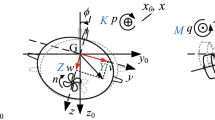Abstract
In this paper, maximum-likelihood (ML) and its relaxation algorithm, which are used to identify the mathematics model of an underwater vehicle(UV), are discussed. With the trial data of zigzag tests, the hydrodynamic derivatives of the UV were estimated, and the relaxation algorithm is confirmed to have better astringency from the contrast between the two methods. Then a simulation environment based on these parameters is established to verify the validity and effect of these methods. The result shows the model is credible and the methods are very useful for the research of maneuverability and adaptive control of underwater vehicles.
Similar content being viewed by others
References
Haddara M R. Wang Yie. Parametric identification of maneuvering for ships [J]. International Shipbuilding Progress, 1999, 46(445):5–27.
Cai Jinshi. System identification and modeling of dynamics system [M]. Biejing: National Defence Industry Press, 1994.
Tsamg K M. Identification of fuzzy logic controllers[J]. Control and Intelligent Systems, 1998, 26(2):37–41.
Author information
Authors and Affiliations
Rights and permissions
About this article
Cite this article
Liu, Jc., Liu, Xm. & Xu, Yr. Application of ML to system identification for underwater vehicle. J. Marine. Sci. Appl. 1, 21–25 (2002). https://doi.org/10.1007/BF02921412
Received:
Issue Date:
DOI: https://doi.org/10.1007/BF02921412




